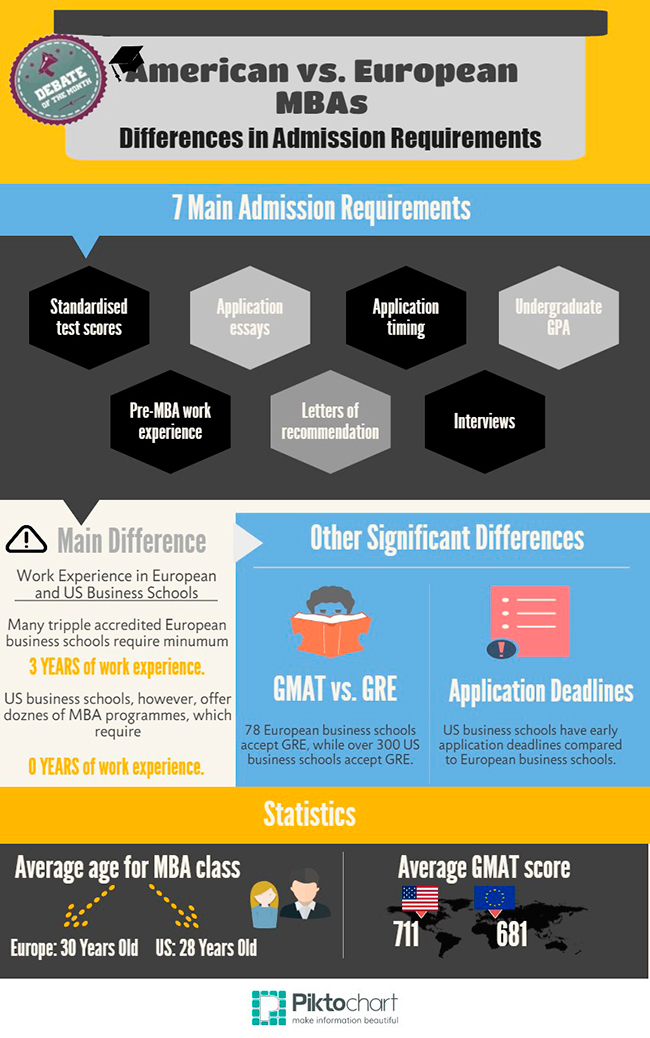
The MBA journey continues long after you actually finish your programme. We can even romanticise that statement and say that once you head down the MBA road, it goes on forever. The beginning of that road, however, has a pretty definite starting point – the application process.
Familiarise yourself with the various US MBA admission criteria
Applying to get admitted in a worthy school to pursue the most prestigious business degree in the world can be overwhelming, confusing and extremely time-consuming. It can be even more complex if you have researched universities in both the United States and Europe, and gradually find yourself more and more mixed up about the various admissions criteria. That is why it is very important to carefully familiarise yourself with the specifics of the different schools – some of them have earlier deadlines for application package submission than others or may accept entrance exam formats that other institutions don’t.
Generally speaking, there are seven main requirements for MBA admission (in no particular order):
- Standardised test scores
- Application essays
- Application timing
- Undergraduate GPA
- Pre-MBA work experience
- Letters of recommendation
- Interview
Many universities in the United States and Europe have the same or similar MBA admission requirements when it comes to the format of the interviews and the application essays, and the requirements for undergraduate and former work experience. However, there are several key differences that you need to be aware of.
The standardised test scores – GMAT vs. GRE
According to ETS spokeswoman Christine Betaneli in a Bloomberg Businessweek article, currently only 78 European business schools accept the GRE as a business school entrance exam. This is no surprise as Europe only started to warm toward the GRE in 2006, when ETS and GMAC dissolved a non-compete agreement. In contrast, earlier in 2014 the U.S. News & World Report published a list of top ranked American business schools that accept GRE and the schools on this list numbered nearly 300! Furthermore, currently 29 out of the top 30 full-time MBA programmes located in the United States as per Bloomberg Businessweek business school rankings accept the GRE. That is one of the fundamental differences in admission requirements between European and American business schools. And it shouldn’t be underestimated. You should know that some schools have a tendency (although this isn’t really on the record) to treat GMAT more favourably than the GRE, and vice versa, when it comes to considering MBA applicants, so do your homework and research the situation at the schools of your choice.

US MBA admission timing – prepare your package early on
Another key difference between the American and the European MBA admission criteria is the application timeline. The US schools have significantly earlier deadlines so make sure you carefully research the dates of the different application rounds. For instance, 9 September 2014 was the first round application deadline of Harvard Business School, which is a week earlier than it was in 2013. Even though these early deadlines may appear a bit scary at first glance, they are a great incentive for you to get focused and systematically prepare all elements of your application package in advance. That way you will increase your chances of being admitted to your chosen programme because you will have everything ready in time to apply in any later intake round.
Find a source that you visit regularly so you can keep track of the newly announced deadlines of the different schools. Additionally, keep in mind that some schools have only two application rounds, whereas others have as many as four! A general rule of thumb is to apply as early as possible before most of the seats in class are filled.
Dozens of US MBA programmes do not require pre-MBA work experience
Yet another crucial difference between the admission requirements of European and American MBAs is the work experience you would need in order to be not only admitted but even considered for a programme. Doing an MBA is a career step that is traditionally pursued by professionals with at least several years of work experience. However, growing numbers of prospective business professionals want to give themselves an edge and decide that an MBA is the right choice for them right after finishing their undergraduate studies. Unfortunately, the majority of the European MBAs require at least three years of work experience so this gives freshly graduated candidates no chance of being considered. The United States, on the other hand, offers dozens of programmes that do not require any work experience. Many of their students, of course, have some experience, but if you are fresh out of university with your Bachelor’s diploma in hand and want to go straight for an MBA, you should definitely get acquainted with your options.
All in all, the foundation of the admission requirements of all MBA programmes is the same. The differences we discussed are crucial, but they don’t affect how you would prepare for your MBA journey. Rather, these differences may impact your decision on when to start preparing for your application and in what way (due to the different entrance exam options).
Don’t forget that the intention of our Debate of the Month is to offer you current trends and up-to-date statistics and facts about each topic that we choose. But it is you who will help us determine the winner of each debate! Ask questions below each article and share your opinion because your contribution counts!
Read the opinion of the opponent in “European MBA Admission is Applicant-friendly“
Check out all debate topics at American vs European MBAs.


Comments